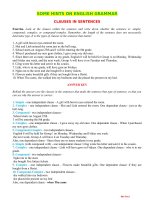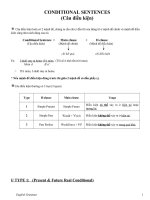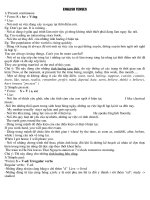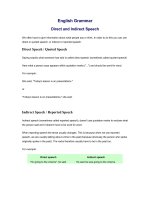Functional English Grammar 1
Bạn đang xem bản rút gọn của tài liệu. Xem và tải ngay bản đầy đủ của tài liệu tại đây (68.34 KB, 34 trang )
Functional English Grammar:
An Introduction for Second
Language Teachers
Mr. Trương Văn Ánh
Unit 1
Basic concepts
Formal and functional grammar
Formal grammar focuses on rules which
specify all the possible grammatical structures
of the language. It analyzes sentences made
up to illustrate different grammatical rules
rather than sentences drawn from real world
sources.
Functional grammar considers language a
communicative tool and grammar is analyzed
to discover how it is organized to allow
speakers and writers to make and exchange
meanings. Functional grammar focuses on the
appropriate
form
for
a
particular
communicative purpose in a particular
context.
1) Thi No was loved by Chi Pheo.
2) Chi Pheo loved Thi No.
Formal grammar sees the two sentences as an
active and a passive while functional grammar
consider them two kinds of communication.
Levels of analysis
Linguists usually identify the following four
levels:
Phonology
Lexis
Grammar
Semantics
Phonology shows the sound system of a
particular language.
Lexis or lexicology refers to words of
vocabulary of a language.
Grammar refers to (1) the arrangement of
words and (2) the internal structure of words.
Ex: Jack played tennis in the court yesterday.
The words are arranged in a grammatical string
which is meaningful. It is called syntax. The
verb “played” may be divided into two parts:
“play” + “ed”. The first part indicates an action
and the second marks past tense. This aspect
of grammar is called morphology.
Semantics shows the systems of meaning in a
language.
Sometimes grammar and lexis are put on the
same level and called lexico-grammar.
The organization of grammar
Rank indicates different levels of organization
within grammar. Sentence and Word are two
ranks of grammatical organization. Sentence is
the highest rank of grammatical organization.
Ex: Students play tennis.
This stretch of language includes one sentence
and three words which are called three Units.
The words can be expanded, as follows:
Students who are graders 5 can play tennis.
(i) Students who are graders 5 (expansion of students)
(ii) can play (expansion of play)
(iii) tennis (without expansion)
Two of the three units which are expanded are
called groups.
Sentence
Group (i)
Group (ii) Group (iii)
W
W W W W W W
W
Students who are graders 5 can play tennis
Figure 1: Sentence, group, and word.
Besides word, group, and sentence, another
rank within grammar is clause.
Ex: He learns FG well, and he gets good marks.
The two underlined units are called clauses.
The sentence consists of two clauses. The
word and is a conjunction, and it is
conventionally analyzed as belonging to the
second clause.
In sum, there are four ranks within grammar:
word, group, clause, and sentence.
Sentence
Clause 1
Clause 2
Group Group Group Group Group Group Group Group
W
W
W
W
W
W
W W
W
He learns FG well, and he gets good marks
Figure 2: Sentence, clause, group, and word.
There are four word classes ( traditionally
known as parts of speech). Let’s look at the
word classes of the following sentence.
N
V
N
Students play tennis.
It is possible to label the groups the same class
labels.
NG
VG
Students who are graders 5 can play tennis
Two other major word classes are adjective
and adverb. It is certain to label their groups
the same class labels.
Adj
Adj
Jack is handsome.
Jack has loyal friends.
Adj G
Daisy raises a very wise dog.
Adv
Luckily, she won the lottery.
Adv G
He works extremely hard.
Sometimes the term group is replaced by
phrase. As a result, there are also noun
phrase, verb phrase, adjective phrase, and
adverb phrase. In this book the only phrase
used is the prepositional phrase. It begins
with a preposition and after it exists an object.
VG
NG/OBJECT
Ex: The train approached the platform.
VG
NG/OBJECT
The troop crossed the field at night.
Prepositional phrases
PREP NG/PREP Obj
toward the platform
PREP NG/PREP Obj
across the field
Embedding
The noun group in - Students who are graders 5
– contains within it a clause - who are graders
5.
Embedding is a case where one unit is used as
a constituent of another unit at the same or a
lower rank
Exercise
Analyze clauses, groups and phrases in the
following sentences. Label the word class of
each group.
a. That farmer lives in Sen village.
b. Mike met noisy boys.
c. Kathy bought beautiful clothes.
d. Olga took children to school.
e. Frogs hide in wet caves.
Grammatical functions
In terms of functional language teaching,
functions usually mean things such as asking
for directions, describing things and people,
talking about the past, the present, etc. It is
possible uses of language.
There are two grammatical functions: subject
and finite.
Identiying Subjects
A question tag is added to the clause to
identify the subject.
Tag
Ex: The door is locked, isn’t it?
a. Subjects are certain kinds of clauses
+ Subjects are That clauses
Ex: That SGU has made considerable contribution
to the national education is true.
+ Subjects are Wh- clauses
Ex: What he has just said makes her surprised.
When the president comes is kept secret.
+ Subjects are infinitive clauses
Ex: To motivate him to give up smoking is her goal.
+ Subjects are V-ing clauses
Ex: Leaving Russia early made Messi very sad.
b. Subjects are five pronouns: I, He, She, We,
and They
Ex: I believe in your competence.
c. Subjects are noun groups (or nominal clauses)
Ex: The front door was robust.
Identifying finites
Finites are recognized by adding a question tag.
+ When a verb group includes a Finite, the Finite
will always be the first constituent of the verb
group.
Ex: Kathy has been learning Spanish for two
years.
When a verb group has only one word, the
word is the Finite.
Ex: A mason won the Vietlott.
+ Only Finites are marked for tenses.
Ex: Mike didn’t go to the party.
Past simple
+ Only Finites are marked for number
agreement.
Ex: A number of students are from Long An.
The number of the students is 44.
However, some finites are not marked for
number agreement.
Ex: The committee can pass the bill today.









